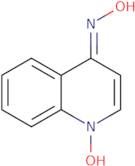4-(Hydroxyamino)quinoline N-Oxide
CAS : 4637-56-3
Ref. 3D-FH75589
| 5mg | Arrêté | ||
| 10mg | Arrêté | ||
| 25mg | Arrêté | ||
| 50mg | Arrêté | ||
| 100mg | Arrêté |
Informations sur le produit
- (4E)-1-hydroxyquinolin-4(1H)-one oxime
- (4Z)-1-hydroxyquinolin-4(1H)-one oxime
- 4-(Hydroxyamino)quinoline 1-oxide
- 4-Hydroxyaminoquinoline N-oxide
- 4-Hydroxylaminoquinoline 1-oxide
- 4-Hydroxylaminoquinoline N-oxide
- 4-Quinolinamine, N-hydroxy-, 1-oxide
- N-hydroxyquinolin-4-amine 1-oxide
- NSC 177384
- Quinoline, 4-(hydroxyamino)-, 1-oxide
- Voir d'autres synonymes
4-Aminoquinoline N-oxide (4AQNO) is a reactive oxygen species that has been shown to cause cancer in animal studies. 4AQNO is found in the skin cells of patients with cancer, and its reaction mechanism is thought to be similar to that of other reactive oxygen species. The chemical substance 4AQNO reacts with DNA at the level of the pyrimidine bases (cytosine, thymine, and uracil) and causes oxidative damage. This process leads to the formation of 8-hydroxydeoxyguanosine (8OHdG), which can be used as a marker for oxidative damage. Type strain bacteria are more sensitive than wild-type strains to 4AQNO because they lack protective enzymes such as n-oxide reductase. In addition, carcinogenesis is associated with mutations in genes encoding redox potential markers.





